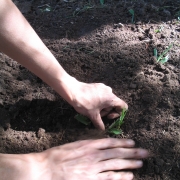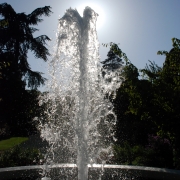Yesterday I went to the Ash Wednesday service at Christ Church Cathedral. If you, like me, went to a service that included the imposition of ashes, you probably heard the words, “Remember that you are dust, and to dust you shall return.”
Remember that you are dust. In one sense, of course, this is a call to remember our mortality. Remember that you are going to die, and in light of that inescapable fact, how are you going to live?
In another, related, sense, it calls us to repentance, reminding us of the sackcloth and ashes of the prophets of old. It calls us to look for the experience that makes part of us die, and turn away from it.
But there’s another significance that occurs to me. In her article, Jesus of the People, Sister Elizabeth A Johnson reminds us that, in fact, we are stardust.
Aruther Peacock, a scientist who is also a theologian, explains, “Every atom of iron in our blood would not be there had it not been produced in some galactic explosion billions of years ago and eventually condensed to formthe iron i the crust of the earth from which we have emerged.” Quite literally, human beings are made of stardust.
She goes on to exclaim the ramifications for this when it comes to the incarnation:
. . . In [Jesus’] person, gracious solidarity encompasses not only all people but the whole biological world of living creatures and the cosmic dust of which they are composed. . . . Jesus of Nazareth, composed of star-stuff and earth-stuff, existed in a network of relationships extending through the biological community of Earth to the whole physical universe”. (See Johnson’s article ‘Jesus of the People’ in Holiness and the Feminine Spirit, 2009.)
To remember that we are dust is to remember that we are connected. Connected to the ground beneath our feet, connected to our fellow dust-creatures, and connected to the God who put on dust to join us.
So what does that have to say to us as we consider our well-being?
It turns out that high on the list of factors that influence our sense of well-being are our relationships with others. Australia’s Better Health Channel includes “happy, intimate relationship with a partner”, “network of close friends”, and “a sense of belonging” on its list. Likewise, in its recommendations for achieving well-being, it lists “develop and maintain strong relationships with family and friends”, “make regular time available for social contact”, and “join local organisations or clubs that appeal to you”.
Remembering that we are connected is an exhortation to nurture our relationships and a reminder that no matter how lonely you may feel on any given day–and on a day like Valentine’s, it’s easy to feel it that much more keenly–you are not alone.
Remembering that we are connected also means remembering that our well-being is tied to the well-being of those around us. In that sense, it is both a consolation and a responsibility.
That responsibility features in yesterday’s reading from Isaiah:
If you remove the yoke from among you, the pointing of the finger, the speaking of evil, if you offer your food to the hungry and satisfy the needs of the afflicted, then your light shall rise in the darkness and your gloom be like the noonday. The LORD will guide you continually, and satisfy your needs in parched places, and make your bones strong; and you shall be like a watered garden, like a spring of water, whose waters never fail. . . . You shall be called the repairer of the breach, the restorer of streets to live in.
I want to be careful here, mindful of those whose dedication to others is so great, they can forget to tend to themselves. What is clear is that the two are connected. When we nourish our own well-being, we become, like a watered garden, better able to support those around us. And when we tend to the needs of others, we tend also to our individual and corporate flourishing.
I couldn’t end without saying something about our connection to God. Yesterday evening, as I sat in Christ Church, I realised that I cannot seem to think of Ash Wednesday without also thinking of Good Friday. They are both solemn occasions, both days of fasting, both days on which the shadow of death can linger in the mind. But there is (at least) one stark difference: On Good Friday, the altar is stripped bare, and there is no Eucharist, no Communion, as is fitting on the day we mourn Christ’s death; but on Ash Wednesday, even when we are exhorted to recall all the things we’ve done wrong, individually and corporately, when it would be easy to feel cut off from God by a sense of unworthiness, we are welcomed to God’s table. As we are, dust and imperfections and all.
So today, on St Valentine’s, with the words of Ash Wednesday still ringing in our ears, remember that we are connected.




